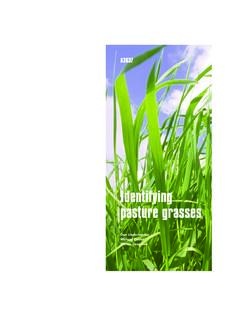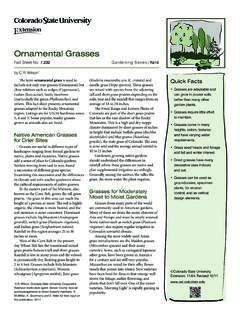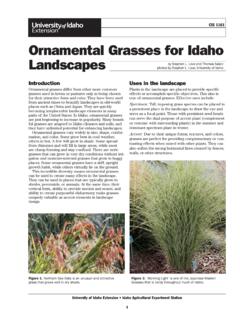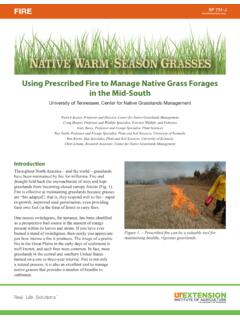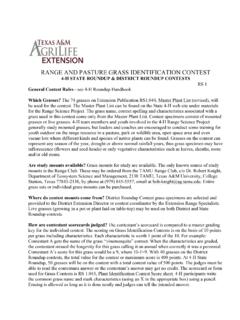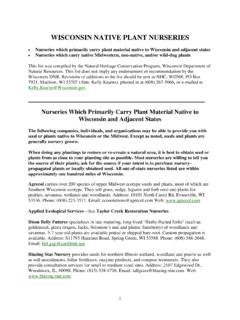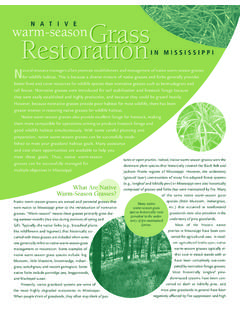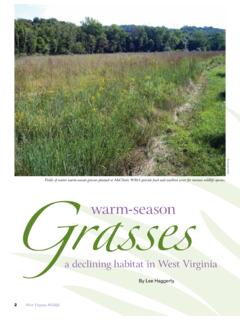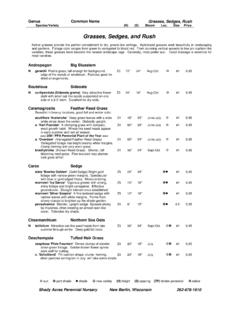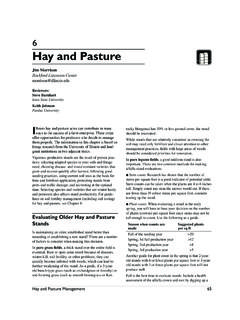Transcription of Identifying pasture grasses - University of Vermont
1 1996 by the Board of Regents of the Universityof Wisconsin System doing business as the divisionof Cooperative Extension of the University ofWisconsin-Extension. Send inquiries aboutcopyright permission to: Director, CooperativeExtension Publications, 201 Hiram Smith Hall,1545 Observatory Dr., Madison, WI :Dan Undersander and Michael Caslerare professors of agronomy, College of Agriculturaland Life Sciences, University of Wisconsin-Madison. Dennis Cosgrove is associate professor ofagronomy, University of Wisconsin-River Undersander and Dennis Cosgrove also holdappointments with University of Wisconsin-Extension, Cooperative Extension. Credits:Produced by Cooperative ExtensionPublications, University of , Linda Deith; designer, Susan Anderson;photographer, B.
2 Wolfgang Hoffmann; illustrator,Jody of Wisconsin-Extension,Cooperative Extension, in cooperation with Department of Agriculture and Wisconsincounties, publishes this information to further thepurpose of the May 8 and June 30, 1914 Acts ofCongress; and provides equal opportunities andaffirmative action in employment andprogramming. If you need this material in analternative format, contact the Officer of EqualOpportunity and Diversity Programs or callCooperative Extension Publications publication is availablefrom yourWisconsin county Extension office or fromCooperative Extension Publications, 630 St., Rm. 170, Madison, Wisconsin 608-262-3346. Before publicizing, pleasecall for publication Identifying pasture GrassesI-08-96-4M-??
3 0 FCIdentifying pasture grassesDan Undersander Michael CaslerDennis CosgroveA3637 ContentsUsing this of a grass a grass plant it a grass?..8 Seed and seedling seeds (3 8inch or larger)..10 Smooth seeds (1 4inch).. (Italian) ryegrass .. seeds (smaller than 1 4inch)..16 Kentucky pasture grassesDan Undersander, Michael Casler, andDennis CosgroveGrasses are the base of Midwesternpastures. They can supply good yields ofquality feed. This booklet identifies the15 most common annual and perennialgrasses in Midwestern pastures: thepredominant seeded midwestern grasses , themost common native pasture grasses (quackgrass and Kentucky bluegrass), and afew annual weedy grasses . While many othergrasses grow in the Midwest, they do notcontribute significantly to the stand or guide will help you identify grassesthe first year, when you need to knowwhether a seeding was successful.
4 It will alsohelp you identify grasses in establishedpastures so you can make informed decisionsabout pasture management, fencing, booklet is organized in three parts: nseed and seedling identification for newplantings, nvegetative identification (with seedheads) for established plants, and ninformation about growth habit andmanagement for each of the seededgrasses. Vegetative grass and seed head wide leaf blade (1 2inch)..26 Smooth medium leaf blade (1 4inch).. narrow leaf blade (lessthan 1 8inch)..34 Kentucky rolled leaf (Italian) folded leaf management and , annual (Italian) and the 2- to 3-leaf stage, use the pulltest to determine whether the grass seedlingis a perennial or an annual. An annual grasswill pull easily and will have many shortroots.
5 A perennial grass will be harder to pulland will have at least one long root that maybreak off when you pull the ve organized the grasses in the seedand seedling section by seed size. When youpull the seedling, look for the seed, which willoften still be attached. Measure the longestdimension of the seed to determine whichcategory (large, medium, or small) it fits page through the appropriate categoryto match the seed and seedling to thephotographs and descriptions. The seeds areenlarged to show detail; for actual size, referto the description at the top of each vegetative grasses andseed headsTo identify grasses in establishedpastures, first check to see whether the grass issod forming (spreading) or bunching (formsclumps). If you re examining a sod-forminggrass, the next step is to look at the width ofthe leaf blades (1 2-inch wide, 1 4-inch wide, orless than 1 8-inch wide).
6 If you re looking at abunch-type grass, check to see whether theunemerged leaf blade is rolled or you ve keyed these two items, turn tothe appropriate category to identify the this guideBefore you plantBefore purchasing grass seeds, you maywant to consult the grass management anddescriptions section of this book. It describesthe ideal uses for each species and outlines thebest techniques for successful establishment,management, and harvest. The speciesinformation chart on page 58 summarizesseeding rates and relative tolerance fordrought, traffic, and weed seeds and seedlingsThe best time to identify seedlings iswhen plants are at the 2- to 3-leaf usually reach this stage 1 to 4 weeksafter germination, depending on the time (shown below)
7 Cansometimes help determine grass GRASSESR yegrassOrchardgrassTall fescueTimothyKentucky bluegrassQuackgrassSmooth bromegrassCreeping foxtailReed canarygrass07142128 Days to germinationGermination timeGlossaryAuricleA short extension of the leaf bladethat wraps partway around the A stiff, hair-like extension on light-colored band of tissue oppositethe ligule, on the outer side of the jointed stem of tiny leaf-like structure envelopingthe area of the stem between bladeThe flat, expanded portion of thegrass membrane or series of hairs on theinner side of the grass leaf where theblade joins the place on the stem where a The point of attachment of a seed tothe seed head or to another part of the leaf that wrapsaround the main of a grass plant54 pasture GRASSESC ross-section of a shoot (showing unemerged leaves)culmcollarrachillaliguleseedawnsh eathnodeglumeinternodeauriclenodefoldedO verlapping (left) and fused(right) bladeGood managers balance pasture qualityagainst yield.
8 The best time to graze isimmediately following the most rapid growthbut before flowering and seeding. A good ruleof thumb is to wait until grasses are 10 inchestall before grazing. At this stage, sufficientcarbohydrate reserves have been built up toallow for rapid regrowth; in addition, bothyield and quality are high (see figure below).If grazing occurs before the forage has hadtime to rebuild its carbohydrate reserves, yieldwill be low, the next regrowth may be slowand reduced, and winter survival may bedecreased. One of the cornerstones of asuccessful grazing system is having restperiods long enough to allow for rapid a grass plant growsPlants get energy from the sun. Throughphotosynthesis, plants convert this energyto carbohydrates which can either be usedfor growth or stored for future use.
9 Forage growth is slow when plants aresmall (early spring growth or after grazing).When plants have few green leaves, they mustrely heavily on stored carbohydrates for theirenergy, illustrated below. As leaves get bigger,photosynthesis increases dramatically,allowing for rapid growth. Before flowering,most pasture plants are growing as fast aspossible if other factors are not limiting. Oncethe plant begins to flower, growth slows sincemost energy is diverted to flower and seedproduction when forage heads quality decreases as plants occurs because, as plants get larger andmore stemmy, a greater percentage ofnutrients and dry matter is tied up in non-digestible forms (such as lignin).76 pasture grasses vegetative growthinternode elongationstem elongationearly headingseedformingcarbohydratereservesve getative growthinternode elongationstem elongationearly headingseedformingqualityyieldbest time to grazeIs it a grass?
10 grasses can sometimes be confused withsedges and rushes. To distinguish them, lookfor the following characteristics:nSedgeshave triangular stems that arefilled with pith. The nodes areinconspicuous and leaves grow fromthe stem in three directions whenviewed from round or flat stems. Stemsare commonly leafy only at the grow from two directions whenviewed from the round or flat are leafy along the entire grow from two directions whenviewed from the GRASSESSEED & SEEDLING IDENTIFICATION grass/rushsedgeQuackgrassVegetative grasses /seed heads, p. characteristicsseedabout 3 8inch longshootfrequently reddish at baseleaf bladedark green, robust; lower surface smoothsheathsides overlap at top; short hairsliguleshort, membranousauriclesnarrow, pointed, and clasping around the stemSmooth bromegrassSpecies description, p.
